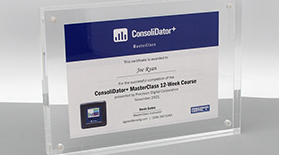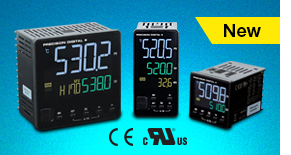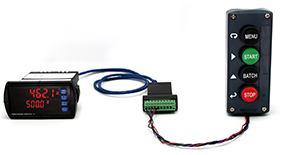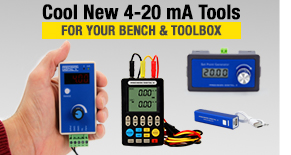

Precision Digital promotes a set of behaviors for its employees. One of these we call Be the Expert. A big part of our value is the knowledge and expertise we bring to every situation. Looking at the articles below, I hope we can share with you information that will increase your value. The ConsoliDator+ provides a new opportunity for you to recapture control of your systems from outsourced PLC programmers. YOU can manage those previously PLC and HMI run applications because YOU can configure and set up the controller. It lets you be the expert, not someone else. Analog 4-20 mA is the most common signal we work with. Below is one of a series of articles offering education on this signal. We also offer the tools you need to measure, interpret, troubleshoot, test, and calibrate 4-20 mA loops. Feedback from the successful ConsoliDator+ MasterClass and SuperNova introduction have shown me that when you become the expert, it helps you do your job better. This newsletter is more than just a product promotion e-mail; it’s your chance to become more of an expert, and better at what you do. I hope you read this newsletter, and find something worthwhile. I think you will. Oh, and when you do? Don’t hesitate to reach out, and let us know!
For decades, process instrumentation has largely relied on 4-20 mA signals to transmit process data easily and reliably. Moreover, it is the signal of choice in the process control industry for many reasons. One in particular is the fact that current does not degrade and it remains constant at any point in the loop, as discussed in our review of the Fundamentals of 4-20 mA Current Loops. Therefore, it is a very efficient means to transmit process information. In most cases, this range represents a two-point linear scale where a 4 mA signal represents 0% of a sensor's measurement, while 20 mA indicates 100% of the measurement. But, why do we use 4-20 mA instead of 0-20 mA? That is a very common question among individuals in the industry. And the answer is simple; a 0 mA signal is not practical. This article will discuss three reasons why a 0 mA signal is not as useful and why 4-20 mA is the industry standard.
12 Weeks sounded like a rather huge commitment when I invited over 100 folks to enroll in the ConsoliDator+ MasterClass, but once they realized we would only meet once per week for no more than 30 minutes, we couldn’t get them signed up quickly enough! They entered the class thinking they would be learning the same features they’ve been trained on in the past with our legacy products and left as experts on a radically different kind of technoloy that is promising to take the process automation industry by storm.
Now each of the students who completed the class have a cost-effective solution to offer when a customer has a control application that must be installed, but their budget cannot afford the time and money it takes to install and program a PLC. With the ConsoliDator+, now salespeople can fulfill their customers’ control needs without having to rely on a third party or systems integrator for programming! The ConsoliDator+ was specifically designed so that anyone can configure the device for any application type.
-Devin Gates, Business Development Manager
If you haven’t taken the course, you still have a chance to become an Expert on the PD9000 ConsoliDator+ Multivariable Controller! Precision Digital has made all the resources from this 12-week course available at predig.com/MasterClass.
Precision Digitals’ New SuperNova PD500 Series is a complete line of auto-tuning PID and on/off controllers. This modern line of controllers shows the process variable (PV), set value (SV), and manipulated value (output level%, MV) on a striking reverse polarity LCD screen. The SuperNovas have two and three 4-digit display lines depending on the DIN size. Easily switch automatic and manual modes by the push of two buttons simultaneously! Available in popular 1/4, 1/8 (V), and 1/16 DIN sizes, and with a shallow depth behind panel of only 2.5" (63 mm) they are easy to fit into almost any panel, product, or enclosure. The SuperNova accepts voltage, current (with external resistor), and direct temperature thermocouple and RTD inputs making it an excellent choice for any control application.
The PDA2364-MSBS Control Station has four buttons with the same labelling as the buttons on ProVu and Helios batch controllers to provide convenient remote operation of these products. These buttons are configured as: black (Menu), green (Start), black (Batch), and red (Stop) and decals next to the buttons identify how the buttons are used for programming.
The PDA2364-MSBS connects to ProVu meters with a PDA1044 digital I/O module and to the Helios meters with no additional hardware. The control stations are also available in 1 and 2 buttons for other applications. See the whole line of PDA2360 control stations.
Precision Digital now provides some cool new tools for working with 4-20 mA and other common signals that are handy to have in your toolbox or on your work bench. The PD9502 is a simple-to-use 4-20 mA or 0-10 VDC signal generator with a 4-digit LED display and a one-turn adjustment knob. The PD9502 can be powered by 15-27 VDC or optional USB power bank. The PD420 set point generator provides a convenient way to generate a 4-20 mA signal that can be used to control another device and features a built-in dial for coarse or fine adjustment. The PD460 valve positioner is programmed to display a value of 0-100% relating to the 4-20 mA output. Both are available in a NEMA 4X enclosure as the PD421 and PD461. The PD9501 multi-function calibrator has a variety of signal measurement and output functions including voltage, current, thermocouple, and RTD. The PD9501 also includes a convenient storage case and 3 easy connector cables.
A customer was using hose pumps to maintain the level of a body of water. When the level got to a certain threshold, a relay would turn a pump on and let it run until the level climbed back down to a reasonable level.
However, since it’s just a relay that’s controlling the pump, when the pump comes on, it comes on at 100% until it is shut off. Obviously, that is not the most efficient way to use a pump, and it will severely decrease the longevity of the pump over time.
There was a problem though. Once in a while, the hose would have a leak in it, which went undetected by the pump controller, and the pump would work even harder to maintain the same flow rate. To prevent those events, the customer would put a 110-amp shut off on the line. If the pump, when running at 100% capacity, exceeded 110 amps, that would indicate a leak in the hose, and cause the pump to shut off before any damage is done.
Hiring a systems integrator to install a PLC and create a custom program is expensive. Worst of all, you cannot change or expand on it yourself. With the ConsoliDator+ multivariable controller you will never need to hire a programmer again and you can regain control of your own process. Watch this video to learn more about the ConsoliDator+ and how it is providing PLC capabilities and HMI visibility without the need for complex PLC programming.
- New PD4 Large Display Loop-Powered Meter
- UL and cUL approvals for ordinary and hazardous locations on ConsoliDator+








